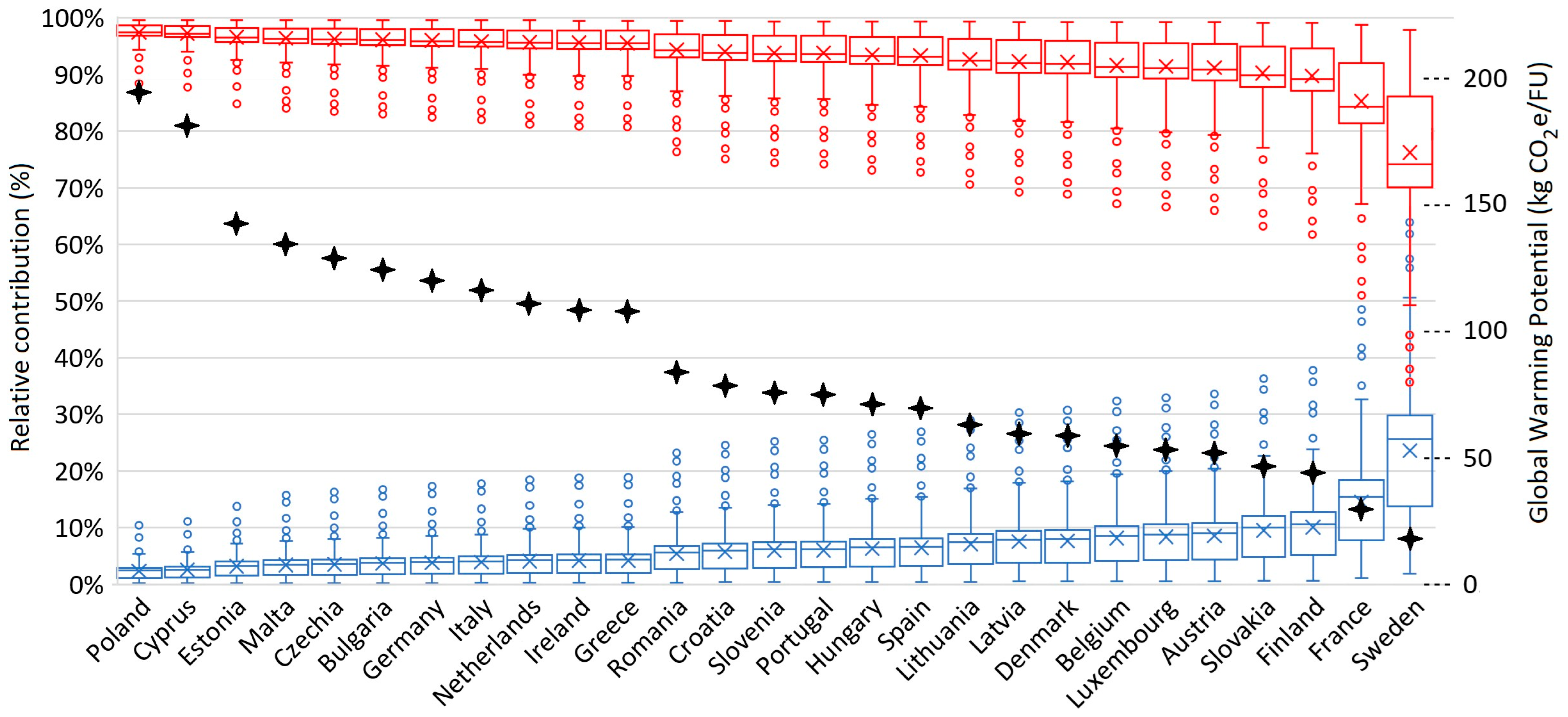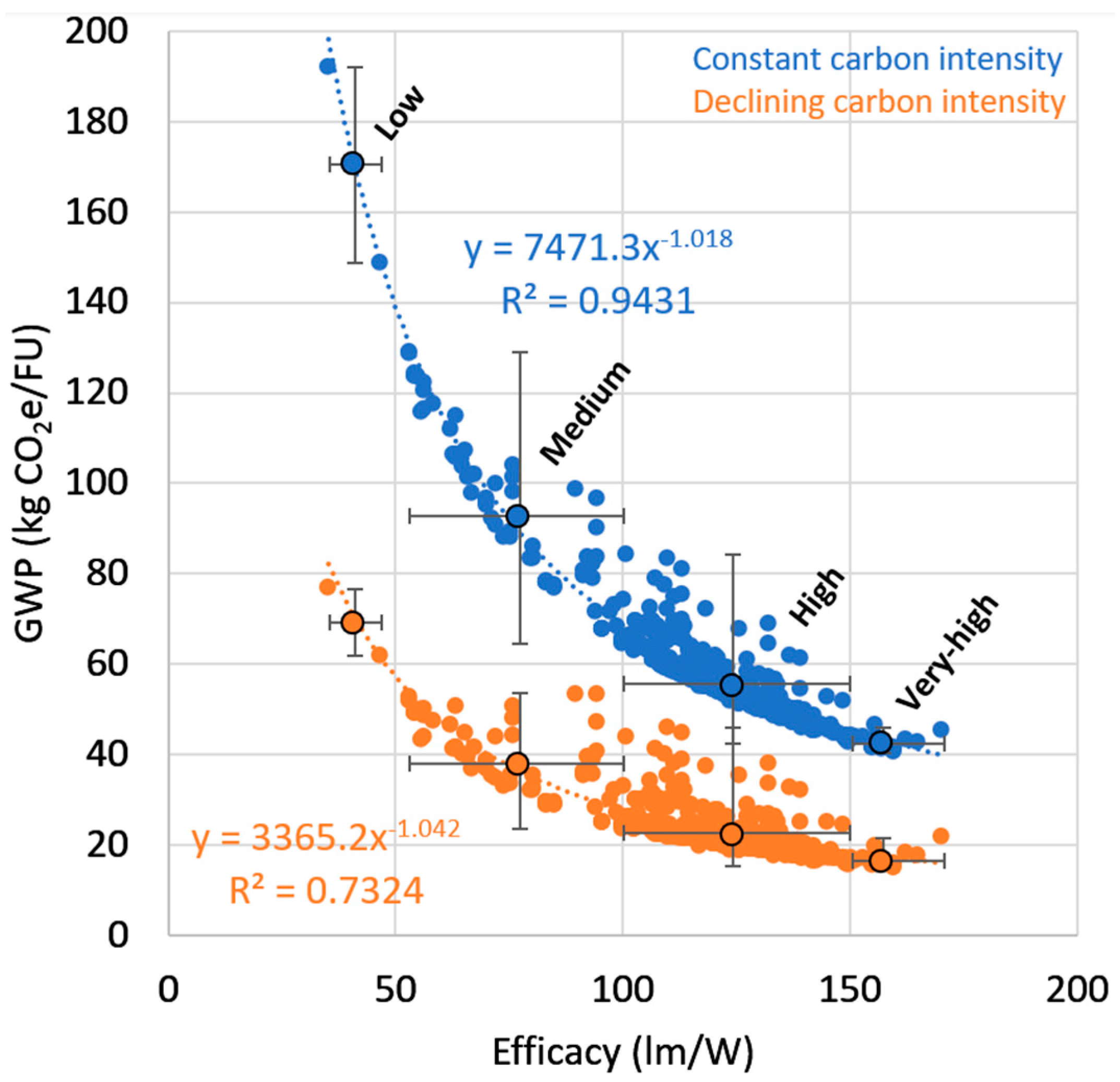Environmental Impacts of Light Sources in Buildings: Analysis of Environmental Product Declarations (EPDs) in European Union
Abstract
:1. Introduction
2. Materials and Methods
2.1. Data Collection
2.2. Data Normalization, Classification, and Analysis
2.3. Life-Cycle Assessment
3. Case Study
4. Results
5. Discussion
6. Conclusions
Supplementary Materials
Author Contributions
Funding
Data Availability Statement
Acknowledgments
Conflicts of Interest
References
- Inter International Energy Agency. Buildings. 2025. Available online: https://www.iea.org/topics/energyefficiency/buildings (accessed on 24 February 2025).
- European Commission. Roadmap for Moving to a Competitive Low Carbon Economy in 2050; European Commission: Brussels, Belgium, 2011; Available online: https://ec.europa.eu/clima/document/download/roadmap_2050_en.pdf (accessed on 24 February 2025).
- Yang, L.; Yan, H.; Lam, J.C. Thermal comfort and building energy consumption implications—A review. Appl. Energy 2014, 115, 164–173. [Google Scholar] [CrossRef]
- Nishimwe, A.M.R.; Reiter, S. Estimation, analysis and mapping of electricity consumption of a regional building stock in a temperate climate in Europe. Energy Build. 2021, 253, 111535. [Google Scholar] [CrossRef]
- Mahmoudzadeh, P.; Hu, W.; Davis, W.; Durmus, D. Spatial efficiency: An outset of lighting application efficacy for indoor lighting. Build. Environ. 2024, 255, 111409. [Google Scholar] [CrossRef]
- Gentile, N.; Lee, E.S.; Osterhaus, W.; Altomonte, S.; Naves David Amorim, C.; Ciampi, G.; Garcia-Hansen, V.; Maskarenj, M.; Scorpio, M.; Sibilio, S. Evaluation of integrated daylighting and electric lighting design projects: Lessons learned from international case studies. Energy Build. 2022, 268, 112191. [Google Scholar] [CrossRef]
- Zocchi, G.; Hosseini, M.; Triantafyllidis, G. Exploring the Synergy of Advanced Lighting Controls, Building Information Modelling and Internet of Things for Sustainable and Energy-Efficient Buildings: A Systematic Literature Review. Sustainability 2024, 16, 937. [Google Scholar] [CrossRef]
- Hafezparast Moadab, N.; Olsson, T.; Fischl, G.; Aries, M. Smart versus conventional lighting in apartments—Electric lighting energy consumption simulation for three different households. Energy Build. 2021, 244, 111009. [Google Scholar] [CrossRef]
- Iatauro, D.; Zinzi, M. Daylight Assessment and Implications on the Overall Energy Need in an Office Building: A Case Study. In Multiphysics and Multiscale Building Physics; Berardi, U., Ed.; Springer Nature: Singapore, 2025; pp. 312–317. [Google Scholar] [CrossRef]
- EN 15193-1:2017; Energy Performance of Buildings—Energy Requirements for Lighting. CEN, European Committee for Standardization: Brussels, Belgium, 2017.
- Hosseini, S.M.; Heiranipour, M.; Wang, J.; Hinkle, L.E.; Triantafyllidis, G.; Attia, S. Enhancing Visual Comfort and Energy Efficiency in Office Lighting Using Parametric-Generative Design Approach for Interactive Kinetic Louvers. J. Daylighting 2024, 11, 69–96. [Google Scholar] [CrossRef]
- Lee, J.H.; Kang, J.-S. Study on Lighting Energy Savings by Applying a Daylight-Concentrating Indoor Louver System with LED Dimming Control. Energies 2024, 17, 3425. [Google Scholar] [CrossRef]
- Mesloub, A.; Alnaim, M.M.; Albaqawy, G.; Alsolami, B.M.; Mayhoub, M.S.; Tsangrassoulis, A.; Doulos, L.T. The visual comfort, economic feasibility, and overall energy consumption of tubular daylighting device system configurations in deep plan office buildings in Saudi Arabia. J. Build. Eng. 2023, 68, 106100. [Google Scholar] [CrossRef]
- Albu, H.; Beu, D.; Rus, T.; Moldovan, R.; Domniţa, F.; Vilčeková, S. Life cycle assessment of LED luminaire and impact on lighting installation—A case study. Alex. Eng. J. 2023, 80, 282–293. [Google Scholar] [CrossRef]
- Clarke-Sather, A.; Li, Y.; Qu, J. Lighting energy use in Anding District, Gansu Province, China. Energy Sustain. Dev. 2016, 32, 40–49. [Google Scholar] [CrossRef]
- Principi, P.; Fioretti, R. A comparative life cycle assessment of luminaires for general lighting for the office–compact fluorescent (CFL) vs Light Emitting Diode (LED)—A case study. J. Clean. Prod. 2014, 83, 96–107. [Google Scholar] [CrossRef]
- Khorasanizadeh, H.; Parkkinen, J.; Parthiban, R.; David Moore, J. Energy and economic benefits of LED adoption in Malaysia. Renew. Sustain. Energy Rev. 2015, 49, 629–637. [Google Scholar] [CrossRef]
- Hasan, M.M.; Moznuzzaman, M.; Shaha, A.; Khan, I. Enhancing energy efficiency in Bangladesh’s readymade garment sector: The untapped potential of LED lighting retrofits. Int. J. Energy Sect. Manag. 2024; ahead-of-print. [Google Scholar] [CrossRef]
- Kocaman, B. Energy Efficiency in Lighting for Historical Buildings: Case Study of the El Aman Caravanserai in Province of Bitlis, Turkey. Light Eng. 2020, 28, 68–76. [Google Scholar] [CrossRef]
- Seyıtoglu, S.S.; Tozlu, Ö.F.; Avcıoğlu, E. Indoor Lighting Conversion Approach for Sustainable Energy Efficiency Applications in Campus Buildings: Hitit University Engineering Faculty Study. Gazi Univ. J. Sci. 2023, 36, 1326–1337. [Google Scholar] [CrossRef]
- Oliveira, L.B.; Salles, R.A.; Fragoso, A.P.; Fortes, M.Z.; Tavares, G.M. Lighting retrofit using LED technology—Efficiency analysis and environmental impacts. In Proceedings of the 2018 Simposio Brasileiro de Sistemas Eletricos (SBSE), Niteroi, Brazil, 12–16 May 2018; pp. 1–5. [Google Scholar] [CrossRef]
- Josijevic, M.; Gordić, D.; Milovanovic, D.; Jurišević, N.; Rakic, N. A method to Estimate Savings of LED Lighting Instalation in Public Buildings the Case Study of Secondary Schools in Serbia. Therm. Sci. 2017, 21, 2931–2943. [Google Scholar] [CrossRef]
- Tähkämö, L.; Bazzana, M.; Ravel, P.; Grannec, F.; Martinsons, C.; Zissis, G. Life cycle assessment of light-emitting diode downlight luminaire—A case study. Int. J. Life Cycle Assess. 2013, 18, 1009–1018. [Google Scholar] [CrossRef]
- Wu, Y.; Su, D. LCA of an industrial luminaire using product environmental footprint method. J. Clean. Prod. 2021, 305, 127159. [Google Scholar] [CrossRef]
- Welz, T.; Hischier, R.; Hilty, L.M. Environmental impacts of lighting technologies—Life cycle assessment and sensitivity analysis. Environ. Impact Assess. Rev. 2011, 31, 334–343. [Google Scholar] [CrossRef]
- DAPHABITAT. 2024. Available online: https://daphabitat.pt/dap/dap-registadas (accessed on 30 January 2024).
- ZAG. 2024. Available online: https://www.zag.si/en/certificates-and-approvals/issued-environmental-product-declarations/ (accessed on 30 January 2024).
- OPENDAP. 2024. Available online: https://node.opendap.es/processList.xhtml?stock=default (accessed on 30 January 2024).
- itb. 2024. Available online: https://www.itb.pl/epd (accessed on 30 January 2024).
- PEP-Ecopassport. 2024. Available online: https://register.pep-ecopassport.org/pep/consult (accessed on 30 January 2024).
- INIES. 2024. Available online: https://www.inies.fr/ (accessed on 30 January 2024).
- Boverket. 2024. Available online: https://www.boverket.se/en/start/building-in-sweden/developer/rfq-documentation/climate-declaration/climate-database/Search/?version=4&climatedatabasequery (accessed on 30 January 2024).
- EPD-Norway. 2024. Available online: https://www.epd-norge.no/ (accessed on 30 January 2024).
- EPD Italy. 2024. Available online: https://www.epditaly.it/en/epd-search/ (accessed on 30 January 2024).
- MRPI. 2024. Available online: https://www.mrpi.nl/epd-overzicht/ (accessed on 30 January 2024).
- EPD Denmark. 2024. Available online: https://www.epddanmark.dk/uk/epd-database/ (accessed on 30 January 2024).
- CO2data. 2024. Available online: https://co2data.fi/rakentaminen/#en (accessed on 30 January 2024).
- RAKENNUSTIETO. 2024. Available online: https://cer.rts.fi/en/rts-epd/searchfor-rts-epds/ (accessed on 30 January 2024).
- BAU-EPD. 2024. Available online: https://www.bau-epd.at/en/epd/list (accessed on 30 January 2024).
- BAUBook. 2024. Available online: https://www.baubook.at/zentrale/ (accessed on 30 January 2024).
- Health Food Chain Safety Environment. 2024. Available online: https://www.health.belgium.be/en/database-environmental-product-declarations-epd#:~:text=Introduction%20to%20the%20B-EPD%20programme%20It%20gives%20a,for%20the%20environment%20and%20often%20allow%20cost%20savings (accessed on 30 January 2024).
- Cenia. 2024. Available online: https://www.cenia.cz/spolecenska-odpovednost/epd/databaze-epd/ (accessed on 30 January 2024).
- DGBC. 2024. Available online: https://www.insideinside.nl/en/ (accessed on 30 January 2024).
- OEKOBAUDAT. 2024. Available online: https://www.oekobaudat.de/no_cache/en/database/search.htm (accessed on 30 January 2024).
- IBU-EPD. 2024. Available online: https://ibu-epd.com/en/ibu-data-start/ (accessed on 30 January 2024).
- Eco-platform. 2024. Available online: https://www.eco-platform.org/epd-data.htm (accessed on 30 January 2024).
- EPD HUB. 2024. Available online: https://www.epdhub.com/ (accessed on 30 January 2024).
- IGBC. 2024. Available online: https://www.igbc.ie/epd-search/ (accessed on 30 January 2024).
- Digital Environmental HUB. 2024. Available online: https://lcadatabase.com/ (accessed on 30 January 2024).
- The International EPD. 2024. Available online: https://www.environdec.com/home (accessed on 30 January 2024).
- Hoxha, E.; Birgisdottir, H.; Röck, M. Climate IMPACT of EU building materials: Data compilation and statistical analysis of global warming potential in environmental product declarations. Sustain. Prod. Consum. 2025, 54, 64–74. [Google Scholar] [CrossRef]
- EN-15804:2012+A2; Sustainability of Construction Works—Environmental Product Declaration—Core Rules for the Product Category of Construction Product. CEN, European Committee for Standardization: Brussels, Belgium, 2019.
- Our World in Data. Carbon Intensity of Electricity Generation. 2023. Available online: https://ourworldindata.org/grapher/carbon-intensity-electricity?region=Europe (accessed on 30 January 2025).
- EN-15978; Sustainability Assessment of Construction Works—Assessment of Environmental Performance of Buildings—Calculation Method. CEN, European Committee for Standardization: Brussels, Belgium, 2011.
- Birgisdottir, H.; Mortensen, L.H.; Hansen, K.; Aggerholm, S. Kortlægning af Bæredygtigt Byggeri [Mapping Sustainable Construction]; The Danish Building Research Institute, Aalborg University: Copenhagen, Denmark, 2013. [Google Scholar]
- Soust-Verdaguer, B.; Obrecht, T.P.; Alaux, N.; Hoxha, E.; Saade, M.R.M.; Röck, M.; Garcia-Martinez, A.; Llatas, C.; de Cózar, J.G.; Passer, A. Using systematic building decomposition for implementing LCA: The results of a comparative analysis as part of IEA EBC Annex 72. J. Clean. Prod. 2023, 384, 135422. [Google Scholar] [CrossRef]
- Aagaard, N.J.; Brandt, E.; Aggerholm, S.; Haugbølle, K. Levetider af Bygningsdele ved Vurdering af Bæredygtighed og Totaløkonomi; SBI forlag: Copenhagen, Denmark, 2013. [Google Scholar]
- Nawrocka, N.; Machova, M.; Jensen, R.L.; Kanafani, K.; Birgisdottir, H.; Hoxha, E. Influence of BIM’s level of detail on the environmental impact of buildings: Danish context. Build. Environ. 2023, 245, 110875. [Google Scholar] [CrossRef]
- EN 12464-1; Lighting and Lighting—Lighting of Workplaces—Part 1: Indoor Workplaces. European Standard: Brussels, Belgium, 2021.
- American Society of Heating, Refrigerating, and Air-Conditioning Engineers. ANSI/ASHRAE/IES Standard 90.1-2016: Energy Standard for Buildings Except Low-Rise Residential Buildings (SI Edition); ASHRAE: Peachtree Corners, GA, USA, 2016. [Google Scholar]
- Ciais, P.; Sabine, C.; Bala, G.; Bopp, L.; Brovkin, V.; House, J.I. Carbon and other biogeochemical cycles. In Climate Change 2013: The Physical Science Basis. Contribution of Working Group I to the Fifth Assessment Report of the Intergovernmental Panel on Climate Change Change; Cambridge University Press: Cambridge, UK, 2014; pp. 465–570. [Google Scholar]
- Reduction Roadmap. Beyond the Roadmap: A Transition Plan for the Danish Building Industry Version 2. 2024. Available online: www.reductionroadmap.dk (accessed on 30 January 2025).
- Nordic Sustainable Construction. Supplementary Agreement on Stricter CO2 Limits for New Buildings in Denmark. 2024. Available online: https://www.nordicsustainableconstruction.com/news/2024/june/tillaegsaftale-paa-engelsk (accessed on 30 January 2025).
- Shanker, L.; Mazzei, I.; Bowes, T. Streamlining life cycle assessment for complex Mechanical Electrical and Plumbing products–Lessons from lighting. Build. Serv. Eng. Res. Technol. 2025, 01436244241305759. [Google Scholar] [CrossRef]
- Mazzei, I.; Saint, R.; Kay, A.; Pomponi, F. Embodied carbon quantification of luminaires using life cycle assessment and CIBSE TM65 methodologies: A comparison case study. J. Ind. Ecol. 2024, 28, 59–73. [Google Scholar] [CrossRef]
- EeBGuide. EeBGuide Guidance Document Part B: Building. In Operational Guidance for Life Cycle Assessment Studies of the Energy-Efficient Building Initiative; Fraunhofer Institut für Bauphysik: Stuttgart, Germany, 2011. [Google Scholar]
- KBOB Database. Eco-bau and IPB 2009/1:2014. Eco-Data in Construction. 2014. Available online: https://www.kbob.admin.ch/kbob/fr/home.html (accessed on 30 January 2025).
- Jusselme, T.; Brambilla, A.; Hoxha, E.; Jiang, Y.; Vuarnoz, D. Building 2050-Scientific Concept and Transition to the Experimental Phase; Swiss Federal Technology Institute of Lausanne: Lausanne, Switzerland, 2016. [Google Scholar]





Disclaimer/Publisher’s Note: The statements, opinions and data contained in all publications are solely those of the individual author(s) and contributor(s) and not of MDPI and/or the editor(s). MDPI and/or the editor(s) disclaim responsibility for any injury to people or property resulting from any ideas, methods, instructions or products referred to in the content. |
© 2025 by the authors. Licensee MDPI, Basel, Switzerland. This article is an open access article distributed under the terms and conditions of the Creative Commons Attribution (CC BY) license (https://creativecommons.org/licenses/by/4.0/).
Share and Cite
Hoxha, E.; Hosseini, S.M.; Soust-Verdaguer, B.; de Boer, J. Environmental Impacts of Light Sources in Buildings: Analysis of Environmental Product Declarations (EPDs) in European Union. Buildings 2025, 15, 1279. https://doi.org/10.3390/buildings15081279
Hoxha E, Hosseini SM, Soust-Verdaguer B, de Boer J. Environmental Impacts of Light Sources in Buildings: Analysis of Environmental Product Declarations (EPDs) in European Union. Buildings. 2025; 15(8):1279. https://doi.org/10.3390/buildings15081279
Chicago/Turabian StyleHoxha, Endrit, Seyed Morteza Hosseini, Bernardette Soust-Verdaguer, and Jan de Boer. 2025. "Environmental Impacts of Light Sources in Buildings: Analysis of Environmental Product Declarations (EPDs) in European Union" Buildings 15, no. 8: 1279. https://doi.org/10.3390/buildings15081279
APA StyleHoxha, E., Hosseini, S. M., Soust-Verdaguer, B., & de Boer, J. (2025). Environmental Impacts of Light Sources in Buildings: Analysis of Environmental Product Declarations (EPDs) in European Union. Buildings, 15(8), 1279. https://doi.org/10.3390/buildings15081279







